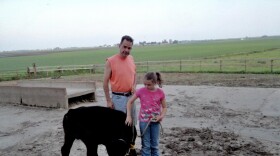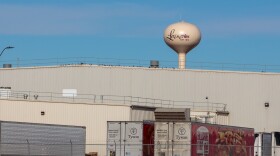Environmental Reporting at WNIJ
The Mississippi River Basin spans nearly half of the continental United States. Millions of residents rely on the river system for drinking water, commerce and recreation.
More than 90% of America’s agricultural exports are grown in the Mississippi River Basin, including more than three-quarters of the world’s exports in feed grains, and most of the country’s livestock. More than 70% of nitrate pollution in the Mississippi River comes from agriculture, which harms human health and aquatic life and contributes to the “dead zone” in the Gulf of Mexico. As the impacts of climate change become more severe, residents can expect more extreme weather, including flooding.
By making resources available on this beat, we support more complete coverage of these critical topics. As our reporters build deeper knowledge, they tap into a network of newsrooms, experts, and support that will help them tell more equitable, impactful and interconnected stories.
Harvest Public Media reports on food systems, agriculture and rural issues through a collaborative network of reporters and partner stations throughout the Midwest and Plains. Our goal is to provide in-depth and unbiased reporting on complex issues for a broad, diverse audience, often connecting the Heartland to the rest of the country. Primary topics include, but are not limited to, agribusiness, biofuels, climate change, farming and ranching, food safety, rural life and public policy.

Below you will find reporting from reporters across our collaborations.
Locally, Jess Savage reports on clean air, water, and agricultural systems in northern Illinois for WNIJ, part of the Mississippi River Basin Project and Harvest Public Media. They recently graduated from the Medill School of Journalism at Northwestern University. Jess was awarded the Pulitzer Center Campus Consortium Fellowship, where they reported on landscape-scale ecological restoration in England and its effects on local farmers. They studied ecology at the University of Vermont as an undergraduate.
Jess focuses on access and policy related to clean air, water and agricultural systems for northern Illinois residents. This includes storytelling that gives voice traditionally underserved communities and the impact of climate change on local communities. The beat is a solutions driven approach to reporting related to efforts to improve the quality of rivers and groundwater, policies and processes in agricultural practices and food systems, and overall access to healthy living.
-
Producers across the central U.S. are facing high input costs as the trade war puts crop markets in an uncertain position. Agriculture economists say they’re watching tariffs and the cattle industry — which has boosted income for some farmers.
-
Winter holiday festivals have become a regular way to grow revenue for America’s smallest towns. And with more people shopping online, those events are key to pulling people away from their screens and into stores.
-
Mientras los agricultores enfrentan vientos contrarios históricos y dificultades del mercado, aumentan las llamadas a la línea directa nacional de Farm Aid y a la línea directa de Iowa Concern.
-
Equine herpesvirus can spread easily and debilitate an animal. A recent outbreak canceled several events across the country, but animal health authorities say cases seem to be easing.
-
The announcement that Tyson would shutter a massive beef processing plant in Nebraska was the first such closure in more than a decade. Beef processors are running at lower capacity, as the U.S. cattle herd size is the smallest it's been since the 1950s.
-
The massive tax and spending law signed in July halts a federal incentive for residential solar, and homeowners and installers are hurrying to complete projects before the end of the year. Industry experts say there are other ways to cut costs like "group buys."
-
At grassland sites worldwide, including the Midwest and Great Plains, scientists simulated extreme drought conditions. The study provides a far-reaching and systematic look at the effects of drought severity.
-
The Trump administration has announced $12 billion in relief for farmers but that won’t cover all their losses.
-
Most of the package is earmarked for row-crop producers. It aims to help farmers – especially those who grow soybeans – balance out losses from high costs and a trade war with China.
-
As farmers face historic headwinds and market hardships, calls to the national Farm Aid hotline and the Iowa Concern hotline are increasing.









